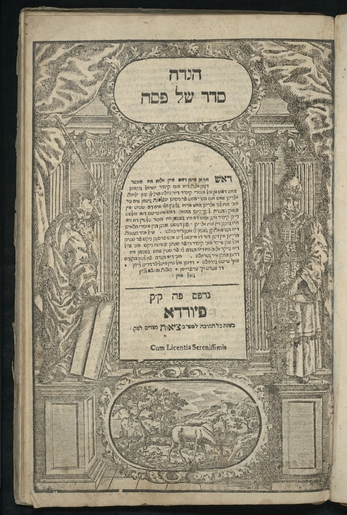Haggadot at the Leo Baeck Institute
A Chronology of LBI's Haggadot Collection











Haggadot were among the first Jewish religious texts printed in the 15th century and among the earliest texts to be illustrated. The earliest known printed Haggadot were published outside of Germany in places like Italy and Turkey. The earliest known illustrated Haggadah to be printed in Germany was a Latin translation in 1512 intended to promote humanism and Christian Hebraism. Over the decades, other Haggadot were printed in Augsburg, Prague, and Amsterdam. While in the 16th century only about 25 Haggadot are known to have been printed, by the 18th century there were more than 200 printed, and by the 19th century over a thousand. By the 20th century the number had increased even more.

The LBI Library contains nearly 200 Haggadot printed from the 17th century to the 21st century. The earliest Haggadot in the LBI Library are from Prague (1687) and Amsterdam (1695).

In the 18th century, Haggadot began appearing in cities with large Jewish communities; LBI Library's Haggadot collection represents German-speaking Jewish communities in Europe including Sulzbach (1764), Offenbach (1789), Brno (1788), Vienna (1797) and Metz (1767).

The largest number of 18th century Haggadot in LBI Library's collection were printed in Fürth, with seven copies printed between the years 1740 and 1791. Many 18th century Haggadot offered parallel Yiddish or Judeo-German translations, like a Haggadah printed with a German translation in Hebrew letters by the Mendelssohn follower Joel Löwe. By the end of the 19th century, most Haggadot published in German-speaking lands had parallel German translations with Latin letters in lieu of Yiddish. The use of German in Jewish religious texts can perhaps be considered a sign of German-Jewish assimilation.

Many Haggadot printed in the 19th Century copied illustrations from earlier editions, like a Haggadah published in 1823 by Anton Schmid, which copied an illustration of the Passover Seder from a 17th century Venetian Haggadah.

The Haggadot in LBI's collection are the books most likely to exhibit signs of use. It is not uncommon for prayer books to show signs of past use, like photographs, note cards, pressed flowers, a lock of hair, or even torn pages that have been stitched back together by hand; Haggadot in particular often show signs of joyous ceremony – with candle wax, wine and food stains, and sometimes matzoh crumbs in the folds between the pages.


One of the most well-known 20th century Haggadot was a translation by Wolf Heidenheim that was published (and frequently republished) by M. Lehrberger in Rödelheim. This Haggadah appears to have been mass produced - it came in inexpensive paper boards and its cheap paper are often chipped and yellowed with age. The Lehrberger Haggadah was published in Germany throughout the first half of the 20th century, ending with the 13th edition in 1938.
The 20th century saw the development of beautifully illustrated Haggadot by Jewish graphic artists, like the Budko Haggadah (1921).

While some scholars speculate that Haggadot were originally illustrated to keep the attention of children and adults alike through the long Passover Seder, the 20th century brought the first Haggadot written just for children, like Die Haggadah des Kindes published in 1933. This "Child's Haggadah" is unique in that in incorporates moveable parts such as pull tabs and volvelles.
Pictured here is the search for the afikoman in Die Haggadah des Kindes. Berlin: Hebräischer Verlag „Menorah,“ 1933. LBI Library, r (q) BM 675 P45 B4 S5 1933 Copy 2
Another image of Die Haggadah des Kindes of a volvelle depicting the ten plagues.
While these Haggadah often have little or no monetary value, they are often held onto for generations for their sentimental significance. Occasionally, Haggadot include inscriptions with genealogical notes, marking the significance of the Haggadah as both an object for a ritual as well as an heirloom.

Bibliography:
Yerushalmi, Yosef Hayim. Haggadah and History: A Panorama in Facsimile of Five Centuries of the Printed Haggadah. Philadelphia, The Jewish Publication Society of America, 1975.